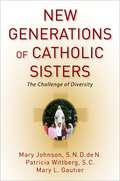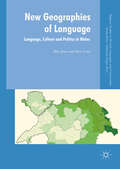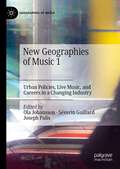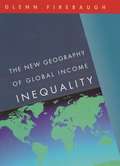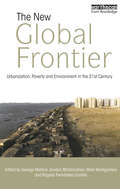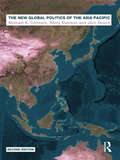- Table View
- List View
The New Futures of Exclusion: Life in the Covid-19 Aftermath
by Daniel Briggs Luke Telford Anthony Lloyd Anthony EllisBased upon global data and following on from Lockdown: Social Harm in the COVID-19 Era, this book discusses the rise of surveillance capitalism and new forms of control and exclusion throughout the Covid-19 pandemic. It particularly addresses the use of vaccine passports, mandates and the new forms of capital extraction and political control that emerged throughout the pandemic. The book also explicates how the ‘vaccine hesitant’ became marginalized in both mainstream discourse and through regulatory interventions. Whilst the book addresses the wider political economy within which so-called ‘anti-vaxxers’ were ostracized, it also explores the complex nature of their sentiments. The book closes by considering The New Futures of Exclusion, outlining the forms of surveillance and control that may be implemented in the future particularly in light of the challenges brought by global warming and the energy transition. It is a broadly accessible text, particularly appealing to policymakers, general readers and academics in sociology, political sociology, politics, human geography, political economy, criminology, social policy, psychology, history, and infectious diseases and medicine.
New Games: Postmodernism After Contemporary Art (Theories of Modernism and Postmodernism in the Visual Arts)
by Pamela M. LeePamela M. Lee’s New Games revisits postmodernism in light of art history's more recent embrace of "the contemporary." What can the theories and practices associated with postmodernism tell us about the obsession with the contemporary in both the academy and the art world? In looking at work by Dara Birnbaum, Öyvind Fahlström and Richard Serra, among others, Lee returns to Jean-Francois Lyotard's canonical text The Postmodern Condition as a means to understand more recent art-critical interests in interactivity, collectivism and neo-liberalism. She reads Lyotard's well-known treatment of language games relative to the game theory associated with the Cold War and the rise of the information society. New Games asks readers to think critically about our recent past and the embattled state of our contemporary preoccupations. With a critical introduction by Johanna Burton, New Games is the fourth and penultimate volume in Routledge’s series of short books on the theories of modernism by leading art historians on twentieth-century art and art criticism.
New Games: Postmodernism After Contemporary Art (Theories of Modernism and Postmodernism in the Visual Arts)
by Pamela M. LeePamela M. Lee’s New Games revisits postmodernism in light of art history's more recent embrace of "the contemporary." What can the theories and practices associated with postmodernism tell us about the obsession with the contemporary in both the academy and the art world? In looking at work by Dara Birnbaum, Öyvind Fahlström and Richard Serra, among others, Lee returns to Jean-Francois Lyotard's canonical text The Postmodern Condition as a means to understand more recent art-critical interests in interactivity, collectivism and neo-liberalism. She reads Lyotard's well-known treatment of language games relative to the game theory associated with the Cold War and the rise of the information society. New Games asks readers to think critically about our recent past and the embattled state of our contemporary preoccupations. With a critical introduction by Johanna Burton, New Games is the fourth and penultimate volume in Routledge’s series of short books on the theories of modernism by leading art historians on twentieth-century art and art criticism.
The New Gender Paradox: Fragmentation and Persistence of the Binary
by Judith LorberToday, in Western countries, we are seeing both the fragmentation of the gender binary (the division of the social world into two and only two genders) and its persistence. Multiple genders, gender-neutral pronouns and bathrooms, X designations, and other manifestations of degendering are becoming common, and yet the two-gender structure of our social world persists. Underneath the persistence of the binary and its discriminatory norms and expectations lurks the continuance of men’s power and privilege. So there is the continued need to valorize the accomplishments of women, especially those of denigrated groups. This succinct and thoughtful book by one of the world’s foremost sociologists of gender shines a light on both sides of this paradox – processes in the fragmentation of gender that are undermining the binary and processes in the performance of gender that reinforce the binary, and the pros and cons of each. The conclusion of the book discusses why we haven’t had a gender revolution and how degendering would go a long way in creating gender equality.
The New Generation of Computable General Equilibrium Models: Modeling the Economy
by Federico Perali Pasquale Lucio ScandizzoThis book covers some important topics in the construction of computable general equilibrium (CGE) models and examines use of these models for the analysis of economic policies, their properties, and their implications. Readers will find explanation and discussion of the theoretical structure and practical application of several model typologies, including dynamic, stochastic, micro-macro, and simulation models, as well as different closure rules and policy experiments. The presentation of applications to various country and problem-specific case studies serves to provide an informed and clearly articulated summary of the state of the art and the most important methodological advancements in the field of policy modeling within the framework of general equilibrium analysis. The book is an outcome of a recent workshop of the Italian Development Economists Association attended by a group of leading practitioners involved in the generation of CGE models and research on modeling the economy and policy making. It will be of interest to researchers, professional economists, graduate students, and knowledgeable policy makers.
The New Generation Z in Asia: Dynamics, Differences, Digitalization (The Changing Context of Managing People)
by Elodie Gentina, Emma ParryThis book is the first to compare the Asiatic Generation Z (born 1990–1995) in terms of country and culture specific drivers and characteristics based on interdisciplinary and international scientific research. Although Asia has been the focus of many articles and books on demographics, politics and economics, few authors understand in depth the behaviour of the young people in their roles as consumers and as new members of the working world. The New Generation Z in Asia: Dynamics, Differences, Digitalization explores how specific Asiatic cultures translate into a creative and innovative society in order to conduct business to adjust their recruitment and retention strategies, also examining how they attract and retain the best young talent in Asia. Written for academics and professionals in the fields of Management, Organizational Behaviour, Marketing, and Human Resource Management, this work examines a set of topics that describe societal and managerial feelings, goals, concerns and behaviours of a vast continent that stretches from East Asia through South Asia, Southeast Asia to Western Asia.
The New Generation Z in Asia: Dynamics, Differences, Digitalization (The Changing Context of Managing People)
by Elodie Gentina Emma ParryThis book is the first to compare the Asiatic Generation Z (born 1990–1995) in terms of country and culture specific drivers and characteristics based on interdisciplinary and international scientific research. Although Asia has been the focus of many articles and books on demographics, politics and economics, few authors understand in depth the behaviour of the young people in their roles as consumers and as new members of the working world. The New Generation Z in Asia: Dynamics, Differences, Digitalization explores how specific Asiatic cultures translate into a creative and innovative society in order to conduct business to adjust their recruitment and retention strategies, also examining how they attract and retain the best young talent in Asia. Written for academics and professionals in the fields of Management, Organizational Behaviour, Marketing, and Human Resource Management, this work examines a set of topics that describe societal and managerial feelings, goals, concerns and behaviours of a vast continent that stretches from East Asia through South Asia, Southeast Asia to Western Asia.
New Generations of Catholic Sisters: The Challenge of Diversity
by Mary Johnson Mary L. Gautier Patricia WittbergThis book offers a comprehensive examination of the generations of women who entered religious life in the United States after 1965. It provides up-to-date demographics for women's religious institutes; a summary of canon law locating religious life within the various forms of life in the Church; an analysis of Church documents on religious life; and data on the views of post-Vatican II entrants regarding ministry, identity, prayer, spirituality, the vows, and community. Beginning each chapter with an engaging narrative, the authors explore how different generations of Catholic women first became attracted to vowed religious life and what kinds of religious institutes they were seeking. By analyzing the results of extensive national surveys, the authors systematically examine how the new generations of Sisters differ from previous ones, and what those changes suggest about the future. The book concludes with recommendations for further understanding of generations within religious life and within the Church and society. Because of its breadth and depth, this book will be regarded by scholars, the media, and practitioners as an essential resource for the sociological study of religious life for women in the United States.
New Generations of Catholic Sisters: The Challenge of Diversity
by Mary Johnson Patricia Wittberg Mary L. GautierThis book offers a comprehensive examination of the generations of women who entered religious life in the United States after 1965. It provides up-to-date demographics for women's religious institutes; a summary of canon law locating religious life within the various forms of life in the Church; an analysis of Church documents on religious life; and data on the views of post-Vatican II entrants regarding ministry, identity, prayer, spirituality, the vows, and community. Beginning each chapter with an engaging narrative, the authors explore how different generations of Catholic women first became attracted to vowed religious life and what kinds of religious institutes they were seeking. By analyzing the results of extensive national surveys, the authors systematically examine how the new generations of Sisters differ from previous ones, and what those changes suggest about the future. The book concludes with recommendations for further understanding of generations within religious life and within the Church and society. Because of its breadth and depth, this book will be regarded by scholars, the media, and practitioners as an essential resource for the sociological study of religious life for women in the United States.
The New Genetics: Social and Ethical Implications for Users and Providers
by Irmgard Nippert Heidemarie Neitzel Gerhard Wolffciples and recommendations on genetic service provision in a multidisciplinary way. At the workshop the main issues and principles that are presently emerging as integral parts of national and international recommendations on genetic service provision such as: - voluntary provision of services - protection of choices - patient autonomy - informed consent - nondirective counseling - confidentiality were discussed and the participants tried to assess how these principles are known, met or violated in practice according to the newest up-to-date research findings and to identify existing gaps in data provision, research and policy analy sis. The workshop brought together an international multidisciplinary group of well known experts including health professionals, molecular biologists, social scientists and ethicists as well as representatives of patient organizations and pol icy makers who presented and discussed the newest data and survey findings on selected ethical and social issues in the provision of new genetic tests. The main scientific contributors to this meeting have been awarded grants from ELSI, ESLA, BIOMED 1 and BIOMED 2 programs as well as national grants.
The New Genetics and The Public's Health
by Robin Bunton Alan PetersenThe rapid advancement of genetic science, fuelled by the Human Genome Project and other related initiatives, promises a new kind of public health practice based on the pre-detection of disease according to calculations of genetic risk. This book by two well-known sociologists: * explores the implications of the new genetics for public health as a body of knowledge and a domain of practice * assesses the impact of new genetic information and technologies on conceptions of health, illness, embodiment, self and citizenship * critically examines the complex discourses surrounding human genetics and public health. The New Genetics and The Public's Health addresses the emerging social and political consequences of the new genetics and provides a stimulating critique of current research and practice in public health.
The New Genetics and The Public's Health
by Robin Bunton Alan PetersenThe rapid advancement of genetic science, fuelled by the Human Genome Project and other related initiatives, promises a new kind of public health practice based on the pre-detection of disease according to calculations of genetic risk. This book by two well-known sociologists: * explores the implications of the new genetics for public health as a body of knowledge and a domain of practice * assesses the impact of new genetic information and technologies on conceptions of health, illness, embodiment, self and citizenship * critically examines the complex discourses surrounding human genetics and public health. The New Genetics and The Public's Health addresses the emerging social and political consequences of the new genetics and provides a stimulating critique of current research and practice in public health.
New Geographies of Language: Language, Culture and Politics in Wales (Palgrave Studies in Minority Languages and Communities)
by Rhys Jones Huw LewisThis book develops a novel approach to the study of language, bringing it into dialogue with the latest geographical concepts and concerns and provides a comprehensive account of the geography of Welsh language analysing policy development, language use, ability and shift. The authors examine in particular: the different ways in which languages can be mapped; how geographical insights can be used to develop understandings of language use; the value of assemblage theory as a way of interpreting the social, technical and spatial aspects of language policy development; and the geographies that characterise institutional engagements with languages. This book will set a research agenda for the geographical study of language, developing a conceptual framework that will offer fresh insights to researchers in the fields of Applied Linguistics, Sociolinguistics, Minority Languages, Geolinguistics, and Public Policy.
New Geographies of Music 1: Urban Policies, Live Music, and Careers in a Changing Industry (Geographies of Media)
by Ola Johansson Séverin Guillard Joseph PalisThis book is the first installment of a trilogy that explores the spatial dimensions of music. Music has generated substantial interest among geographers, but other academic disciplines have also developed related spatial perspectives on music. This trilogy brings together multiple approaches, each book investigating a bundle of interrelated themes. New Geographies of Music 1: Urban Policies, Live Music, and Careers in a Changing Industry starts with an introduction that explores contemporary approaches to the study of popular music. The following chapters address a range of issues, including the role of live music in urban development, how knowledge about local music ecosystems circulates among cities, urban networks of music production, how musical practices in local scenes are affected by core-periphery relations, and how musicians rely on touring in order to earn a living. This is a must-read for anyone interested in the relationship between space and music.
New Geographies of Music 2: Music in Urban Tourism, Heritage Politics, and Place-Making (Geographies of Media)
by Ola Johansson Séverin Guillard Joseph PalisThis book is the second installment of a trilogy that explores the spatial dimensions of music. Music has generated substantial interest among geographers, but other academic disciplines have also developed related spatial perspectives on music. This trilogy brings together multiple approaches, each book investigating a bundle of interrelated themes. New Geographies of Music 2: Music in Urban Tourism, Heritage Policies and Place-making starts by exploring contemporary approaches to the study of popular music, as well as the relations existing between music, tourism, heritage and urban geography. The chapters address a range of issues, including how music shapes the “feel” of touristic towns and urban public spaces, how music scenes have an increasing role in heritage and tourism policies, and how this recognition of music has consequences on artistic practices and urban imaginaries. This is a must-read for anyone interested in the relationship between space and music.
New Geographies of the Globalized World (Routledge Studies in Human Geography)
by Marcin Wojciech SolarzGlobalization has, essentially, come to an end. It is, already, a victorious revolution. It has profoundly restructured the relationships between people and the world, often recreating them in a new geographical image. This book discovers and describes these relationships of new geographies, providing a comprehensive spatial guide to the globalized world of the 21st century. It considers a number of timely and important themes and insights for the present and future world, exploring topics such as population trends and migration; development, the urban; transportation; religion; our endangered planet; wars, conflicts and terrorism, and disease. As such it offers a cross-cutting synthesis of the modern world. It will be of interest to students and researches in humanities and social sciences, including geographers, economists, political scientists and IR specialists.
New Geographies of the Globalized World (Routledge Studies in Human Geography)
by Marcin Wojciech SolarzGlobalization has, essentially, come to an end. It is, already, a victorious revolution. It has profoundly restructured the relationships between people and the world, often recreating them in a new geographical image. This book discovers and describes these relationships of new geographies, providing a comprehensive spatial guide to the globalized world of the 21st century. It considers a number of timely and important themes and insights for the present and future world, exploring topics such as population trends and migration; development, the urban; transportation; religion; our endangered planet; wars, conflicts and terrorism, and disease. As such it offers a cross-cutting synthesis of the modern world. It will be of interest to students and researches in humanities and social sciences, including geographers, economists, political scientists and IR specialists.
The New Geography of Global Income Inequality
by Glenn FirebaughThe surprising finding of this book is that, contrary to conventional wisdom, global income inequality is decreasing. Critics of globalization and others maintain that the spread of consumer capitalism is dramatically polarizing the worldwide distribution of income. But as the demographer Glenn Firebaugh carefully shows, income inequality for the world peaked in the late twentieth century and is now heading downward because of declining income inequality across nations. Furthermore, as income inequality declines across nations, it is rising within nations (though not as rapidly as it is declining across nations). Firebaugh claims that this historic transition represents a new geography of global income inequality in the twenty-first century. This book documents the new geography, describes its causes, and explains why other analysts have missed one of the defining features of our era—a transition in inequality that is reducing the importance of where a person is born in determining his or her future well-being.
New Ghosts, Old Ghosts: Prisons and Labor Reform Camps in China
by James D. Seymour Michael R AndersonMuch has been written about the laogai (sometimes likened to the Soviet gulag) in the People's Republic of China. Depending on the source, the prisons are described as nonexistent, enlightened institutions, or hellish places that subject the inmates to degradation and misery. The system is commonly thought of (by admirers and critics alike) as having a measurable impact on the national economy and providing significant resources to the state. Based on research in classified documents and extensive interviews with former prisoners, judicial personnel, and other insiders, and featuring case studies dealing with the three northwestern provinces, this book examines such assertions on the basis of the facts about this underexamined subject in order to arrive at a detailed, objective, and realistic picture of the situation. In the case of each province under study, the authors discuss the history of the provincial prison system and the impact that each has had at the macro, meso, and micro levels.
New Ghosts, Old Ghosts: Prisons and Labor Reform Camps in China (Socialism And Social Movements Ser.)
by James D. Seymour Michael R AndersonMuch has been written about the laogai (sometimes likened to the Soviet gulag) in the People's Republic of China. Depending on the source, the prisons are described as nonexistent, enlightened institutions, or hellish places that subject the inmates to degradation and misery. The system is commonly thought of (by admirers and critics alike) as having a measurable impact on the national economy and providing significant resources to the state. Based on research in classified documents and extensive interviews with former prisoners, judicial personnel, and other insiders, and featuring case studies dealing with the three northwestern provinces, this book examines such assertions on the basis of the facts about this underexamined subject in order to arrive at a detailed, objective, and realistic picture of the situation. In the case of each province under study, the authors discuss the history of the provincial prison system and the impact that each has had at the macro, meso, and micro levels.
The New Gilded Age: The Critical Inequality Debates of Our Time (Studies in Social Inequality)
by David Grusky Tamar Kricheli-KatzIncome inequality is an increasingly pressing issue in the United States and around the world. This book explores five critical issues to introduce some of the key moral and empirical questions about income, gender, and racial inequality: Do we have a moral obligation to eliminate poverty? Is inequality a necessary evil that's the best way available to motivate economic action and increase total outpt? Can we retain a meaningful democracy even when extreme inequality allows the rich to purchase political privilege? Is the recent stalling out of long-term declines in gender inequality a historic reversal that presages a new gender order? How are racial and ethnic inequalities likely to evolve as minority populations grow ever larger, as intermarriage increases, and as new forms of immigration unfold? Leading public intellectuals debate these questions in a no-holds-barred exploration of our New Gilded Age.
The New Global Frontier: Urbanization, Poverty and Environment in the 21st Century
by George Martine Gordon McGranahan Mark Montgomery Rogelio Fernandez-CastillaThe world?s developing countries will be experiencing massive increases in their urban populations over the 21st century. If managed intelligently and humanely, this growth can pave the way to sustainable development; otherwise, it will favour higher levels of poverty and environmental stress. The outcome depends on decisions being made now. The principal theme that runs through this volume is the need to transform urbanization into a positive force for development. Part I of this book reviews the demography of the urban transition, stressing the importance of benefi cial rural-urban connections and challenging commonly held misconceptions. Part II asks how urban housing, land and service provision can be improved in the face of rapid urban expansion, drawing lessons from experiences around the world. Part III analyses the challenges and opportunities that urbanization presents for improving living environments and reducing pressures on local and global ecosystems. These social and environmental challenges must be met in the context of fast-changing demographic circumstances; Part IV explores the range of opportunities that these transformations represent. These challenges and opportunities vary greatly across Africa, Asia and Latin America, as detailed in Part V. Published with IIED and UNFPA
The New Global Frontier: Urbanization, Poverty and Environment in the 21st Century
by George Martine Gordon McGranahan Mark Montgomery Rogelio Fernandez-CastillaThe world?s developing countries will be experiencing massive increases in their urban populations over the 21st century. If managed intelligently and humanely, this growth can pave the way to sustainable development; otherwise, it will favour higher levels of poverty and environmental stress. The outcome depends on decisions being made now. The principal theme that runs through this volume is the need to transform urbanization into a positive force for development. Part I of this book reviews the demography of the urban transition, stressing the importance of benefi cial rural-urban connections and challenging commonly held misconceptions. Part II asks how urban housing, land and service provision can be improved in the face of rapid urban expansion, drawing lessons from experiences around the world. Part III analyses the challenges and opportunities that urbanization presents for improving living environments and reducing pressures on local and global ecosystems. These social and environmental challenges must be met in the context of fast-changing demographic circumstances; Part IV explores the range of opportunities that these transformations represent. These challenges and opportunities vary greatly across Africa, Asia and Latin America, as detailed in Part V. Published with IIED and UNFPA
The New Global Politics of the Asia Pacific
by Michael K. Connors Rémy Davison Jörn DoschThe new, fully updated second edition of The New Global Politics of the Asia Pacific builds on its coherent framework for understanding the complex international and global politics of the Asia Pacific. The textbook provides an introductory guide for the main frameworks needed to understand the region (realism, liberalism, critical theory), which is reader-friendly while still offering sophisticated competing interpretations. Key content includes: the US in the Asia Pacific; China and Japan in the Asia Pacific; Southeast Asia in the Asia Pacific; India in the Asia Pacific; Russia in the Asia Pacific; Australia in the Asia Pacific; Europe in the Asia Pacific; globalization, regionalism and political economy; Asian values, democracy and human rights; transnational actors; region security order and the impact of terrorism on the region. ? A highly topical account, which provides an overview of the main actors, institutions and contemporary issues such as security, terrorism and transnational actors, the book is required reading for undergraduate students of Asian studies, international politics, and anyone interested in the region.
The New Global Politics of the Asia Pacific
by Michael K. Connors Rémy Davison Jörn DoschThe new, fully updated second edition of The New Global Politics of the Asia Pacific builds on its coherent framework for understanding the complex international and global politics of the Asia Pacific. The textbook provides an introductory guide for the main frameworks needed to understand the region (realism, liberalism, critical theory), which is reader-friendly while still offering sophisticated competing interpretations. Key content includes: the US in the Asia Pacific; China and Japan in the Asia Pacific; Southeast Asia in the Asia Pacific; India in the Asia Pacific; Russia in the Asia Pacific; Australia in the Asia Pacific; Europe in the Asia Pacific; globalization, regionalism and political economy; Asian values, democracy and human rights; transnational actors; region security order and the impact of terrorism on the region. ? A highly topical account, which provides an overview of the main actors, institutions and contemporary issues such as security, terrorism and transnational actors, the book is required reading for undergraduate students of Asian studies, international politics, and anyone interested in the region.





